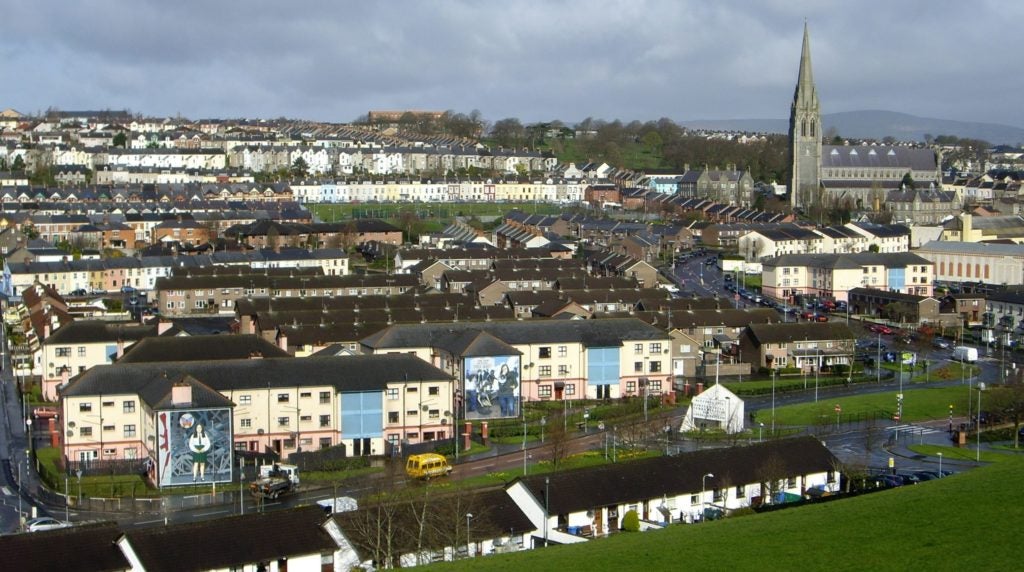“Rediscover Northern Ireland” in D.C.
Megan Rooney (COL ’20) was a senior American Studies Major who traveled to Belfast and Derry courtesy of a Global Irish Studies Fellowship.

In the summer of 2007, the 41st annual Smithsonian Folklife Festival featured an exhibition of Northern Irish culture and heritage on the National Mall in Washington, D.C. Just nine years after the signing of the Good Friday Agreement, the Smithsonian partnered with the Rediscover Northern Ireland Program in an effort to revitalize American tourism to the region. When I first learned about this event, which aimed to celebrate contemporary life in Northern Ireland, a mural painted by Derry’s Bogside Artists caught my attention due to its distinct American symbols. The group’s collage included a peace dove, a depiction of the Statue of Liberty, and a portrait of Dr. Martin Luther King Jr. alongside the title of his famous speech: ‘I Have a Dream.’
The mural illustrated aspects of the transatlantic relationship between America and Ireland, including the history of Irish emigration to the U.S. and Dr. King’s powerful influence on Northern Ireland’s peaceful civil rights movement in 1968. The connection between the Irish nationalist and African American struggle for civil rights is a common theme in several of Northern Ireland’s compelling political murals. I examined these comparative murals in my American Studies senior thesis, as a window into the relationship of solidarity fostered between the Irish and African Americans. I found that the Bogside Artists’ mural for the Smithsonian festival provides a fascinating and complex example of how Northern Ireland’s fiercely local murals may function in a foreign context.
When I spoke earlier this year with Dr. Nancy Groce, the curator of the exhibition, she told me that she traveled to Northern Ireland in the midst of the Troubles. She described for me the scary, dangerous and intense atmosphere of the region, experiencing various security checkpoints and hearing gunfire at night from Queen’s University. Groce witnessed firsthand the significant changes that had taken place when she returned to conduct fieldwork for the 2007 Festival. She noticed that visitors could now walk the streets of Belfast and enter most shops or pubs in Northern Ireland without fear. Exposing this transformation to the American public, and therefore promoting tourism to this part of the United Kingdom, was the motivation behind the Northern Irish government approaching the Smithsonian to be a part of this festival. As for the muralists, Groce stated that they wanted publicity, increasing political mural tourism in Northern Ireland and for some, including David Dee Craig from the East Belfast Muralists, establishing his status as an artist.
Logistically, the Smithsonian had to have equal representation from all sides of the conflict in every aspect of the exhibit, with participants from all six counties, men and women, age diversity, and members from both the Protestant and Catholic communities. The muralists included a nationalist group, the Bogside Artists, and a unionist group, the East Belfast Muralists. The two groups worked on either side of a mock row house to replicate how the murals would appear in Northern Ireland. Groce requested that the muralists submit their detailed plans before the Festival, but they were not restricted or guided by the Smithsonian in their choice of content. The only formal restriction provided was on flags; the Smithsonian requested that the muralists did not display Union Jacks or tricolors because of the tension they create and because, as Groce told me, these flags do not provide a “deep dive into culture.” Despite these two requests, Groce recalled having difficulty working with the Bogside Artists, who refused to disclose their plans prior to the event. She also recalled that David Dee Craig placed Union Jacks on his side of the row house. This was just one of the few hostile interactions that Groce witnessed between the two groups during the event, and a reminder of the continuing political charge of art in Northern Ireland, even many years after the signing of the Good Friday Agreement.
Because of the cultural importance of flags as symbols of identity in Northern Ireland, the Smithsonian’s restriction seems to be less of a suggestion that flags are superficial indicators of culture, and more of a reflection that their presence signals division in the region. Restricting this sort of expression is suggestive of the Rediscover Northern Ireland Program’s objective to present a side of Northern Ireland that was not dominated by the conflict between nationalists and unionists. The state’s economic goals of tourism and investment cover up the distinctions and tensions that still play a role in Northern Ireland’s contemporary life.
The Rediscover Northern Ireland Program’s partnership with the Smithsonian highlights the efforts Northern Ireland has made in the years following the 1998 peace agreement to demonstrate to prospective visitors that the region is more than its legacy of the Troubles. Muralists’ recreated their works in D.C., placing symbols with a long cultural tradition in Northern Ireland into a foreign context. The Program hoped that this D.C. platform would expose aspects of Northern Irish culture that Americans had not known about before, particularly aspects that go beyond the memory of the Troubles. The Bogside Artists’ mural, however, did touch on this history. It depicted American symbols of freedom and peace that tied the conflict and nationalist identities back to the U.S. civil rights movement and its leaders. The East Belfast Muralists’ display of Union Jacks also invoked the discordant political and cultural identities in the region. Northern Ireland’s interest in stimulating their tourist economy, which incorporates the contradictory goals of embracing conflict tourism and de-politicizing communities to disassociate the region from the Troubles, raises the question of whether these murals have shifted from local forms of political expression to global commodity forms. Tourism efforts seem to turn political murals into gestural objects, raising the question of whether this shift undermines the implied solidarity that the murals display with the African American community as well as other international groups.
